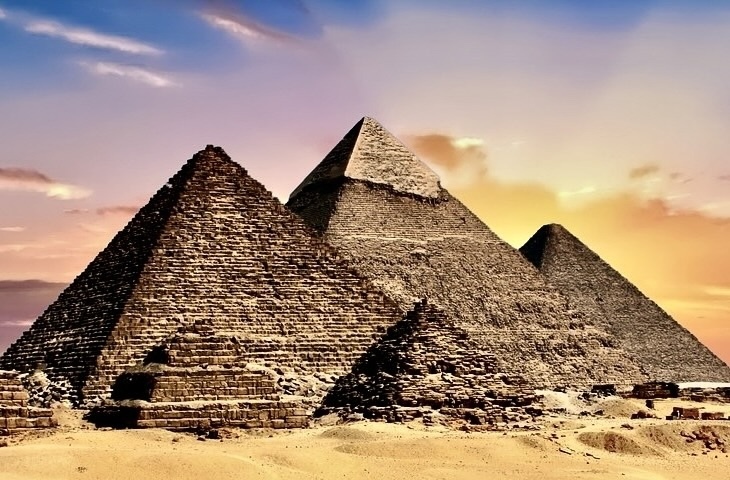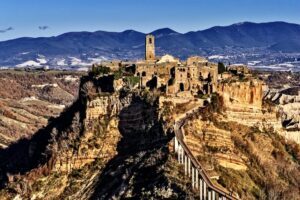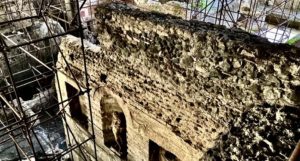
Somma Vesuviana, Italy
By any measure, this appeared to be the most massive ancient villa I had ever seen. Walls towered over me. Peering upward, I stretched my neck to observe their height — at least what was left of their full dimension after their destruction 1600 years ago. Metal scaffolding enveloped them and an enormous metal roof occupied space far above them, shielding them from the sun, wind, rain and other elements of the world outside. I was looking up from deep below ground surface. In contrast to the warmth of the sun’s radiation at ground level above me, the air was cool within this gargantuan, carefully and painstakingly excavated pit and I needed no hat to shield my head and face from the sun’s rays above.
Located near the small town of Somma Vesuviana at the foot of the northern slope of Vesuvius (opposite and invisible from ancient Pompeii and Herculaneum and referenced by some as the ‘dark side’ of Vesuvius), this site was initially discovered in the 1930’s with limited excavation. But the most extensive investigation began in 2002 through a multidisciplinary project with the University of Tokyo. Those excavations, now ongoing, have revealed the walls preserved to a remarkable height, doorways decorated with Dionysiac motifs, a pilastered arcade, apses and interior room walls decorated with frescoes, cisterns, terraces, colonnades — emblematic of spaces created to impress large public audiences — and a large wine cellar with dolia (large earthenware jars), some of which can be seen still buried to their lips in the ground. Scholars have determined that they still contained fermenting grape juice when the eruption occurred. For a time, this was clearly more than a wealthy person’s villa — it was also a production facility for wine, the principal product of the region. Many artifacts, including a marble statue of Dionysus, the god of wine himself, were also recovered in the process. But what we see today is but a fraction of the entire complex that once existed.
The site, known today as the “Villa of Augustus”, or the Dionysiac Villa, is thought to have been first constructed in the 1st or 2nd century AD. Early on, scholars suggested it was a great villa of Augustus Caesar himself (and thus the name), and some have even suggested that Augustus died here, as it is recorded that he died near Nola, which lies not far from Somma Vesuviana. This is under scholarly debate to this day. It’s easy to assume that, like so many other ancient Roman structures in the Vesuvius area, it was destroyed and submerged in the ash from the famous 79 AD eruption — the one that destroyed yet ironically preserved the sensational remains of Pompeii, Herculaneum, and other nearby sites so popular for tourists today. But archaeological investigations have revealed little evidence and effects of the 79 AD eruption at this site. Archaeologists state that the remains we now see of the villa were likely constructed after the 79 AD eruption, in place of whatever was destroyed by that eruption. Unlike the structures of the doomed and lost cities of Pompeii and Herculaneum, this villa, situated by contrast at the north face of Vesuvius, in fact stood and operated for hundreds of years following the Plinian event. This was a great palatial villa that stood at the time of much later eruptions, most notable that of 472 AD (the eruptive material of which lies directly over the structure) and other events that followed, such as the 512, 536 and 1631 AD eruption events.
Research has shown that the area surrounding this side of Vesuvius and the villa continued to be robustly productive agriculturally after the 79 AD event, especially in the form of vineyards and the production of wine. The villa reflects this.
“The main room has many representations of grape bunches, and the stuccoed doorway is decorated with symbols of Dionysus, mystic rituals of his cult, and satyrs and maenads as his companions,” writes The Apolline Project: Illuminating the Dark Side of Vesuvius, a web-based summary report on the recent excavations at the villa. “A marble statue of Dionysus himself – represented as a young boy holding a panther cub in his arms – was originally placed in a niche, where it remained even when the entire building was transformed into a unit for agricultural production. During this transformation, a wine cellar was added to the lower terrace; we can take this as a sign of cultural continuity, despite the significant changes that occurred in religious beliefs and economy in the wider area.”*
Walking among the massive remains, I snapped a photo of a column of great pillars on one side of me. High walls ran perpendicularly at either end of the row of columns. They were adorned with niches that contained and framed at least one statue of Dionysus himself. I could see just below me on the opposite side, another terrace. Here, large, complete vessels lay mostly buried beneath soil. They were filled now with ancient volcanic material, but at one time they contained fermenting grapes. This was the wine cellar. Above this a towering wall of hardened pyroclastic ash and other volcanic material, cut meticulously and painstakingly by teams of archaeologists and other workers, illustrated an impressive record of layer upon layer of successive phases of multiple eruptions over centuries. Eventually, even this volcanic wall will be dug away, revealing what lies beyond and beneath — and what new insights on life in the aftermath of the 79 AD eruption will tell us.
___________________________________
The Dionysiac Villa (Villa of Augustus): Pictorial
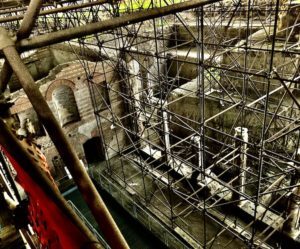
Above and two images below: At first blush, looking down from near the surface as one enters the excavated remains from above.
_______________________________________

_______________________________________
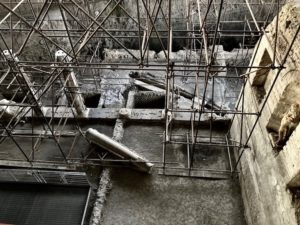
_______________________________________
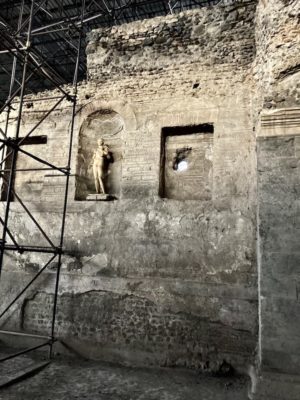
_______________________________________
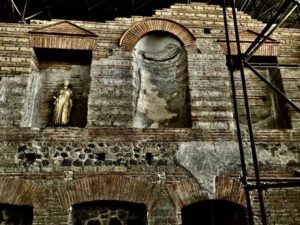
_______________________________________
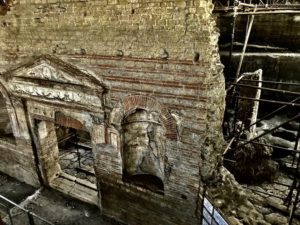
_______________________________________
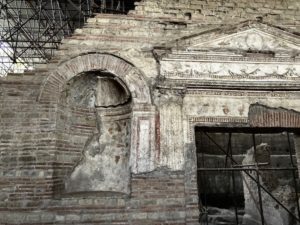
_______________________________________

Note the remarkably well preserved wall fresco painting in the back.
_______________________________________
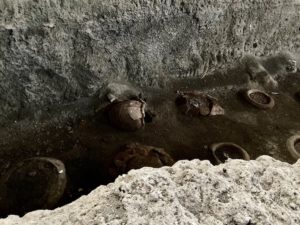
The wine cellar.
_______________________________________
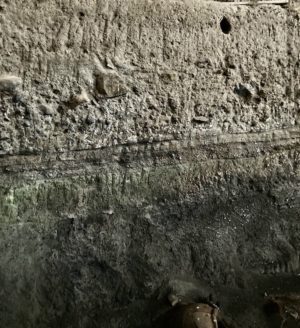
The layers of volcanic material that covered and encased the site exposed.
_______________________________________
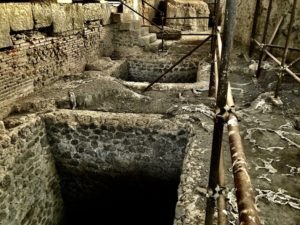
Cisterns
_______________________________________
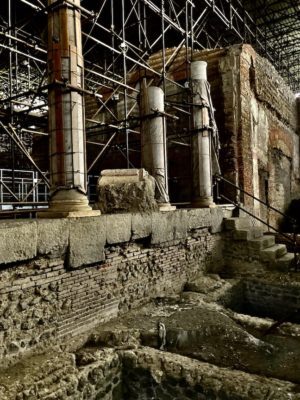
Pilastered arcade remains, cisterns below to the right.
_______________________________________
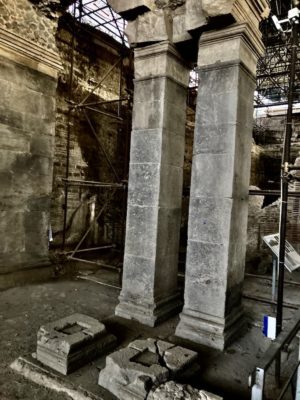
Massive pillars supported the internal structure of the audience hall.
_______________________________________
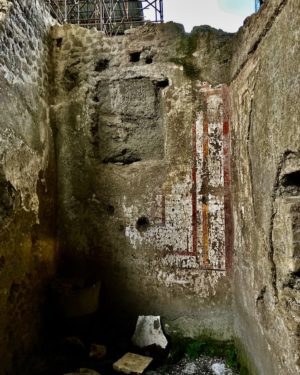
_______________________________________
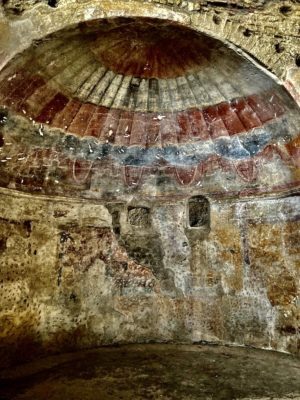
Above and below: Apse, with decorative fresco painting still visible.
_______________________________________
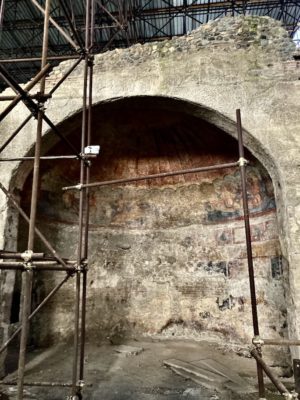
_______________________________________
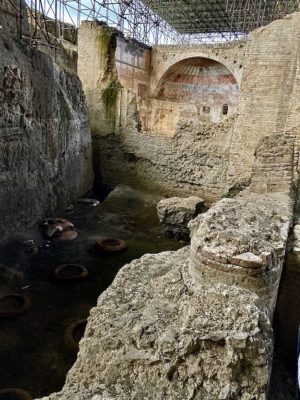
_______________________________________
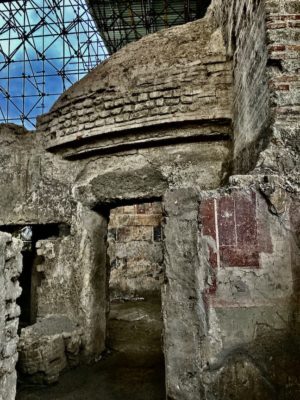
_______________________________________
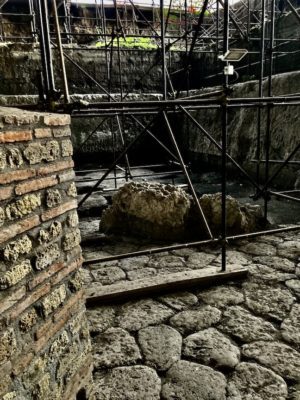
_______________________________________
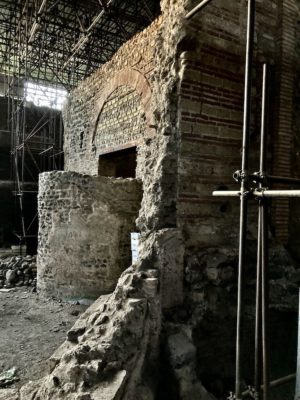
_______________________________________

